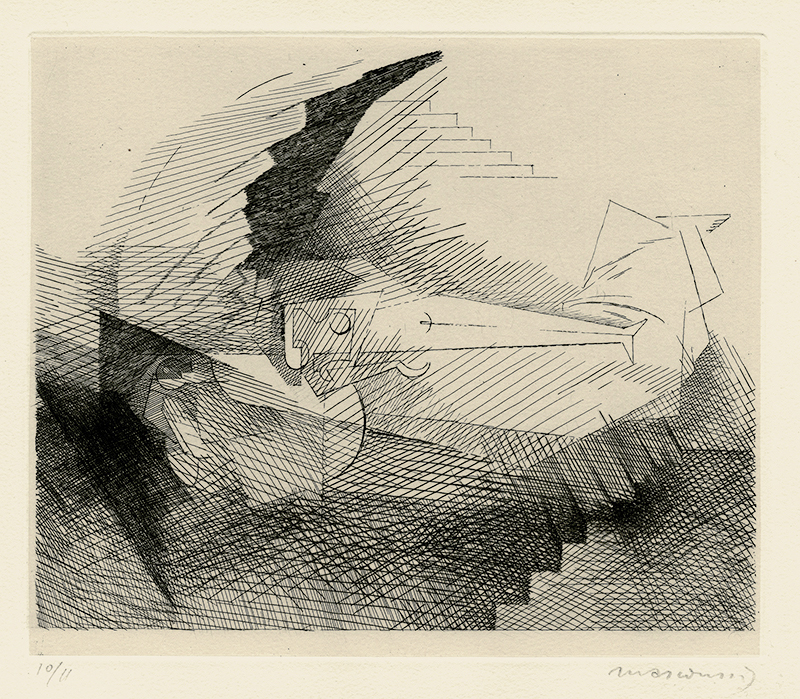Celle que J’amais seul m’aime is an etching printed chine collé from 1931 by Polish born artist Louis Marcoussis. This was published as plate eight in the suite of eleven etchings for Tristan Tzara’s Planches du Salut. The suite was printed in an edition of 77 impressions and within these impressions were ten that were printed chine collé and numbered between 2/11 and 11/11. This impression was printed by Roger Lacourière on Imperial Japon paper supported on ivory Arches and it is pencil signed and editioned 10/11. The suite was published by Jeanne Bucher, Paris and the reference is Lafranchis 75. The platemark measures 8 x 9-3/8 inches.
In 1930 and 1931 Marcoussis executed suites of etchings for two books: Gérard de Nerval's Aurélia and Tristan Tzara's Planches du Salut. in the exhibition catalogue Kubismus Dieter Koepplin comments that in these etchings Marcoussis' cubist forms “tend toward a surrealist suggestiveness.”
Louis Marcoussis, painter and printmaker, was born Ludwig Casimir Ladislas Markous in Warsaw on 14 November 1878. In 1901 he entered the Academy of Fine Arts of Kraków to study painting with Jan Grzegorz Stanislawski. In 1903 Markous moved to Paris, where he worked briefly under Jules Lefebvre at the Académie Julian and became a friend of Roger La Fresnaye and Robert Lotiron. The first time his work was selected for a major exhibition was for the 1905 Salon d'Automne and in subsequent years he continued to exhibit at the Salon des Indépendants and the Salon des Tuileries.
In Paris he made his living by selling caricatures to satirical periodicals, including La Vie Parisienne and Le Journal. He frequented the cafés, such as the Rotonde, Cirque Médrano and the Ermitage, where he met Edgar Degas about 1906 and Braque, Picasso and Apollinaire in 1910. In 1907 Markous abandoned painting and when he began to paint again in 1910, he discarded his earlier Impressionist style to adopt the new Cubist idiom. About 1911, at the suggestion of Apollinaire, be began calling himself Marcoussis, the name of a village near Monthéry in northern France. In 1912 the artist participated in the Salon de la Section d'Or at the Galerie de la Boétie in Paris. By this time his circle included Juan Gris, Fernand Léger, Francis Picabia, Jean Metzinger and Max Jacob. Marcoussis served in the French army from 1914 to 1919, returning to Poland for a visit after his demobilization.
Marcoussis exhibited in 1921 at the gallery of Der Sturm in Berlin with Albert Gleizes and Jacques Villon. He was given his first one-man show in Paris at Galerie Pierre in 1925. This was followed by solo exhibitions in 1928 at the Galerie Le Centaure in Brussels and at the Galerie Georges Bernheim in Paris in 1929. Between the years 1934 and 1935, he stayed for several months in the United States, where one-man shows of his prints opened at The Arts Club of Chicago in 1934 and M. Knoedler and Co. in New York in 1935. Marcoussis worked almost exclusively in graphics from 1930 to 1937 and he illustrated a number of books including Alcools by Apollinaire and Aurélia by Gerard de Nerval. A retrospective of his prints took place at the Palais des Beaux-Arts in Brussels in 1936. The artist traveled in England and Italy in 1938, and during the following year was given a solo exhibition at the London Gallery.
Louis Marcoussis is represented in the collections of museums worldwide, including the Auckland Art Gallery, New Zealand; the Detroit Institute of Arts, Michigan; the Art Institute of Chicago, Illinois; the Cleveland Museum of Art, Ohio; the Indianapolis Museum of Art, Indiana; the British Museum, London; the Metropolitan Museum of Art, and the Museum of Modern Art, New York; the Norton Simon Museum, Pasadena, California; the Philadelphia Museum of Art, Pennsylvania; the Saint Louis Art Museum, Missouri; the McNay Art Museum, San Antonio, Texas; the Guggenheim, Venice; and the National Gallery of Art and the Phillips Collection, Washington, D.C.
In 1940, as the German army advanced, Marcoussis left Paris for Cusset, near Vichy, where he died on October 22, 1941.



